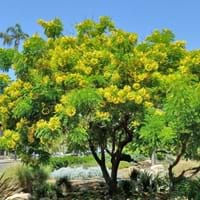Life Span
Biennial
Perennial
Type
Perennial
Flowering Plants, Tree
Types
Not available
Not Available
Habitat
Forests, meadows, Pastures, Prairies, savannahs, Woodland edges
Not Available
USDA Hardiness Zone
8-10
Not Available
AHS Heat Zone
10-6
Not Available
Sunset Zone
H1, 8, 9, 12, 13, 14, 15, 16, 17, 18, 19, 20, 21, 22, 23, 24
Not Available
Habit
Upright/Erect
Upright/Erect
Flower Color
White, Lemon yellow, Light Pink
Yellow
Flower Color Modifier
Bicolor
Bicolor
Fruit Color
Tan
Not Available, White
Leaf Color in Spring
Green
Dark Green
Leaf Color in Summer
Green
Dark Green
Leaf Color in Fall
Not Available
Dark Green
Leaf Color in Winter
Light Green
Dark Green
Leaf Shape
Alternate
Pinnate
Plant Season
Spring, Summer
Spring, Summer, Fall
Sunlight
Full Sun, Partial Sun
Partial shade, Full Shade
Type of Soil
Loam, Sand
Loam
The pH of Soil
Neutral, Alkaline
Acidic, Neutral, Alkaline
Soil Drainage
Well drained
Well drained
Bloom Time
Early Spring, Spring, Late Spring, Early Summer, Late Winter
Indeterminate, Summer
Tolerances
Drought
Drought
Where to Plant?
Container, Ground, Pot
Ground
How to Plant?
Seedlings
Seedlings, Stem Planting
Plant Maintenance
Medium
Medium
Watering Requirements
Average Water Needs, Do Not over Water, Keep the Soil well drained, Requires regular watering
Requires regular watering
In Summer
Lots of watering
Lots of watering
In Spring
Moderate
Moderate
In Winter
Average Water
Average Water
Soil pH
Neutral, Alkaline
Acidic, Neutral, Alkaline
Soil Type
Loam, Sand
Loam
Soil Drainage Capacity
Well drained
Well drained
Sun Exposure
Full Sun, Partial Sun
Partial shade, Full Shade
Pruning
Remove damaged leaves, Remove dead branches, Remove dead leaves
Requires very little pruning
Fertilizers
All-Purpose Liquid Fertilizer
All-Purpose Liquid Fertilizer
Pests and Diseases
Pests and diseases free, Red blotch
Red blotch, Thripes
Plant Tolerance
Drought
Drought
Flower Petal Number
Single
Single
Foliage Texture
Medium
Bold
Foliage Sheen
Matte
Matte
Attracts
Bugs, Butterflies, Insects
Not Available
Allergy
Abdominal pain, Anxiety, Inflammation, Low blood pressure
Not Available
Aesthetic Uses
Beautification, Decorating walls, Hanging Basket, Showy Purposes, Used as an interior landscaping species, Used for decorating walls, fences, gates, hedges, etc.
Showy Purposes
Beauty Benefits
Skin irritation, Skin Problems
Not Available
Environmental Uses
Air purification
Air purification
Medicinal Uses
Eczema, Menstrual Cramps, Menstrual Disorders
No Medicinal Use
Part of Plant Used
Flowers, Root, Seeds, Stem
Whole plant
Other Uses
Beneficial species for attracting pollinators, deer resistant, Edible seed
Used as Ornamental plant
Used As Indoor Plant
Yes
No
Used As Outdoor Plant
Yes
Yes
Garden Design
Mixed Border, Rock Garden, Wall, Wildflower
Shady Tree, Showy Tree
Botanical Name
OENOTHERA mexicana
Cassia leptophylla
Common Name
pinkladies, pink evening primrose, showy evening primrose, Mexican primrose, and amapola.
gold medallion tree
In Hindi
Mexican primrose
gold medallion tree
In German
Rosa Nachtkerze
gold medallion tree
In French
Mexican primrose
gold medallion tree
In Spanish
Primrose mexicana
árbol medallón de oro
In Greek
Μεξικού Primrose
χρυσό δέντρο μετάλλιο
In Portuguese
Mexican Primrose
árvore medalhão de ouro
In Polish
Mexican Primrose
Drzewo Medalion złota
In Latin
Mexicanus Primrose
aureus arbore
Phylum
Tracheophyta
Magnoliophyta
Class
Magnoliopsida
Magnoliopsida
Family
Onagraceae
Fabaceae
Clade
Angiosperms, Eudicots, Rosids
Angiosperms, Eudicots, Rosids
Tribe
Onagreae
Not Available
Subfamily
Onagroideae
Not Available
Number of Species
Not Available
Properties of Mexican primrose and Cassia Leptophylla
Wondering what are the properties of Mexican primrose and Cassia Leptophylla? We provide you with everything About Mexican primrose and Cassia Leptophylla. Mexican primrose doesn't have thorns and Cassia Leptophylla doesn't have thorns. Also Mexican primrose does not have fragrant flowers. Mexican primrose has allergic reactions like Abdominal pain, Anxiety, Inflammation and Low blood pressure and Cassia Leptophylla has allergic reactions like Abdominal pain, Anxiety, Inflammation and Low blood pressure. Compare all the properties and characteristics of these two plants. Find out which of these plant can be used as indoor plant. If you are interested to decorate your house and garden, find out aesthetic uses, compare them and select the plant which will beautify your surrounding. Along with beautification, try comparing medicinal and edible uses of Mexican primrose and Cassia Leptophylla and you can choose the plant having best and most benefits.
Season and Care of Mexican primrose and Cassia Leptophylla
Season and care of Mexican primrose and Cassia Leptophylla is important to know. While considering everything about Mexican primrose and Cassia Leptophylla Care, growing season is an essential factor. Mexican primrose season is Spring and Summer and Cassia Leptophylla season is Spring and Summer. The type of soil for Mexican primrose is Loam, Sand and for Cassia Leptophylla is Loam while the PH of soil for Mexican primrose is Neutral, Alkaline and for Cassia Leptophylla is Acidic, Neutral, Alkaline.
Mexican primrose and Cassia Leptophylla Physical Information
Mexican primrose and Cassia Leptophylla physical information is very important for comparison. Mexican primrose height is 15.20 cm and width 25.40 cm whereas Cassia Leptophylla height is 1,300.00 cm and width 1,200.00 cm. The color specification of Mexican primrose and Cassia Leptophylla are as follows:
Mexican primrose flower color: White, Lemon yellow and Light Pink
Mexican primrose leaf color: Green
Cassia Leptophylla flower color: Yellow
- Cassia Leptophylla leaf color: Dark Green
Care of Mexican primrose and Cassia Leptophylla
Care of Mexican primrose and Cassia Leptophylla include pruning, fertilizers, watering etc. Mexican primrose pruning is done Remove damaged leaves, Remove dead branches and Remove dead leaves and Cassia Leptophylla pruning is done Requires very little pruning. In summer Mexican primrose needs Lots of watering and in winter, it needs Average Water. Whereas, in summer Cassia Leptophylla needs Lots of watering and in winter, it needs Average Water.





